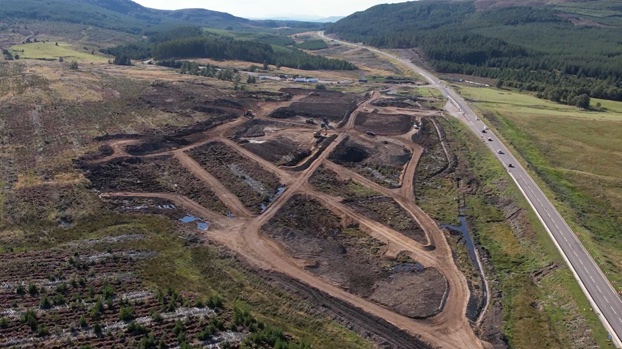An ambitious new peatland project is helping to reduce the environmental impact of the A9 Dualling works between Tomatin and Moy.
Transport Scotland has launched an innovative Peat Management Plan as part of its work to upgrade 9.6km of the A9 from single to dual carriageway, a section that cuts through deep peatland.
Instead of removing and disposing of excavated peat, the plan sets out how the carbon-rich material will be carefully re-used and restored on-site to help tackle climate change.
Peatlands are powerful carbon stores, but traditional construction methods can release that stored carbon into the atmosphere.
The new approach is designed to prevent this and to leave a legacy of environmental benefit long after the road is built.
Working with partners including SEPA and Forestry Land Scotland, Transport Scotland has created a series of carefully engineered “cells” at Allt na Slanaich, where the peat is being relocated.
The site was chosen for its unique ground conditions, which make it suitable for large-scale peat restoration.
Cabinet Secretary for Transport Fiona Hyslop MSP visited the site during Scotland’s first National Innovation Week and praised the project’s forward-thinking approach.
“This embedded approach towards peat management is not only reducing carbon emissions but also protecting one of Scotland’s most valuable natural resources,” she said.
“As we mark National Innovation Week, I’m proud to see A9 Dualling leading the way in applying modern construction methods to meet environmental challenges head-on.”
So far, around 1,000m³ of peat has been transferred to the site each day, with a total of 100,000m³ expected to be managed over the course of the works.
The cells are designed to keep the peat moist, critical for maintaining its carbon-storing function and over time will provide habitat for native flora and fauna, helping to restore lost ecosystems.
Transport Scotland says the site will be monitored for at least five years after construction ends to track outcomes such as soil moisture, biodiversity gains, and ongoing carbon retention.
The Tomatin to Moy stretch of the A9 is one of the most environmentally sensitive sections of the wider dualling programme.
Hyslop added:
“This work shows that major infrastructure doesn’t have to come at the cost of the environment, it can be part of the solution.”





